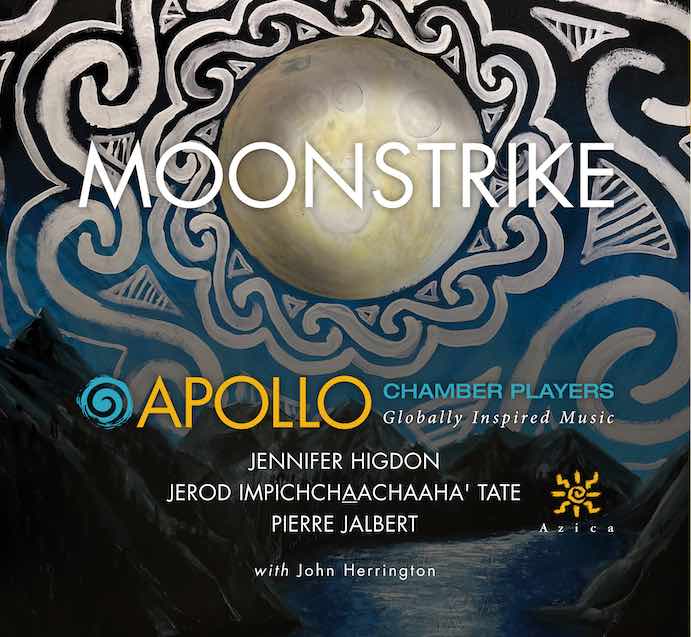Crafting an album that is juxtaposed with whimsey and contemplation while considering the moon is not something many can do thoughtfully. Yet, Apollo Chamber Players have done just that in their latest release, MoonStrike. Released September 2, 2022 on Azica Records, this excellent album is a representation of how the natural world remains relevant. The album features works by Jerod Impichchaachaaha’ Tate, Jennifer Higdon, and Pierre Jalbert, who were all commissioned as part of the Apollo Chamber Players’ 20×20 commissioning project.
Jerod Impichchaachaaha’ Tate’s MoonStrike is the inspiration for the entire album and features narrator John Herrington, the first enrolled member of a Native American tribe to enter space 20 years ago. The eight movement work tells the story of three American Indian legends through arrangements of traditional American Indian Songs and Tate’s original music. Tate’s composition wonderfully depicts elements of the story that are fun to hear and that would likely be even more exciting to experience during a live performance. In the first legend, “Origin of the Moon,” Herrington describes eight young boys stealing the moon from the animal people referenced in the story. The sounds of the boys rolling the moon down the hill across treacherous terrain are brought to life by carefully descending and ascending melodic gestures across the instruments.
“The Man Who Married the Moon” is filled with a range of emotions that are beautifully encapsulated by the Apollo Chamber Players’ stellar performance. The more melancholy moments of the story rely on a longer and slower pace brought by the viola and cello. Emotions of grief and longing demand the players to carefully consider the extent to which they are able to expose feelings as an ensemble.

Jerod Impichchaachaaha’ Tate–Photo by Shevaun Williams
“Raven Steals the Moon” tells the story of an often written about bird: the raven. In this movement, Herrington’s ‘‘CAW! CAW! CAW!” sounds that are meant to mimic ravens increase the intensity of the story as it reaches its apex. Eliciting fewer elements of traditional folk songs, “Raven Steals the Moon” oscillates between moments of excitement with very active fast gestures in the upper strings with slower, more meditative moments in the full ensemble playing. Like many other pieces that are for an ensemble and narration, these stories effectively intrigue and engage the curiosity and attention of listeners of all ages.
Apollo Chamber Players open the album with Jennifer Higdon’s In the Shadow of the Mountain. Higdon uses her opera Cold Mountain as the inspiration and basis for the folk sounds created in this piece. In the Shadow of the Mountain opens in a rather disorienting and unsettling manner, but as the piece progresses, one begins to hear Higdon’s call to the mountains as the pace and meter quicken. The mood of the piece often resembles the varying environmental forces encountered in Appalachia: sometimes arid and dry, but mostly humid and warm. In the Shadow of the Mountain captures something that is so important about folk music and that is almost indescribable — a sense of something that is distant, and yet, shockingly familiar.
Jennifer Higdon (Photo by A. Bogard)
Pierre Jalbert’s L’esprit du Nord (Spirit of the North) completes this recording. French-Canadian folk songs are the source material for much of the three movements. Chanson de Lisette is a beautifully set theme and variations featuring the first violin, while Cantique opens with a striking contrast as a 1940s field recording of someone singing is dubbed atop the string quartet. A ‘Passion’ song and Les Pèlerins — both religious folk songs — are contained within this movement, and Jalbert uses call and response, a compositional form widely used in sacred settings. The extra-musical material played at the beginning of Fiddle Dance, the third and final movement of the piece, is another 1940s recording of a harmonica and spoons. Jalbert’s dance very much plays into elements of traditional folk music, including the repeated use of thematic material and percussive tapping as to mimic the feet of people dancing.
Chickasaw artist Dustin Illetewahke Mater used the memory of his Muskogean ancestors to create the beautiful album cover art of a moon striking through the night amidst mountains and water. MoonStrike is a decidedly folk album that demonstrates the many elements contemporary composers can elicit from different genres. This album is equal parts celebratory and revelatory: The celebration is through the stories of how the moon is more than a rock-like object that comes out at night and retreats as the sun rises. The revelation is that the moon is something that we all witness, sometimes without even noticing.
I CARE IF YOU LISTEN is an editorially-independent program of the American Composers Forum, funded with generous donor and institutional support. Opinions expressed are solely those of the author and may not represent the views of ICIYL or ACF.
A gift to ACF helps support the work of ICIYL. For more on ACF, visit the “At ACF” section or composersforum.org.

